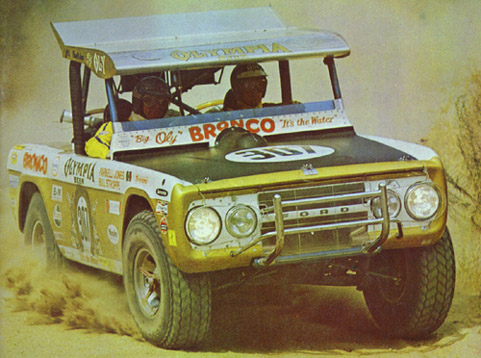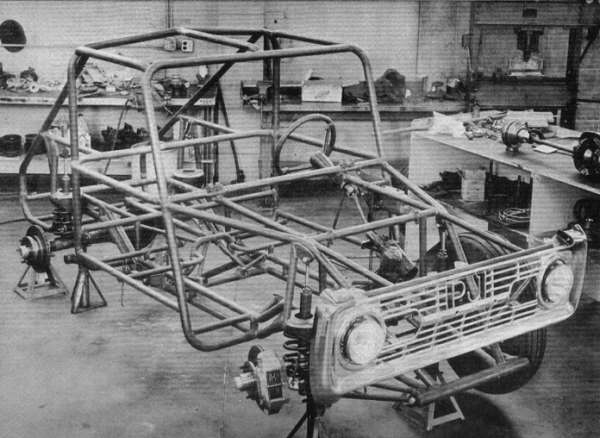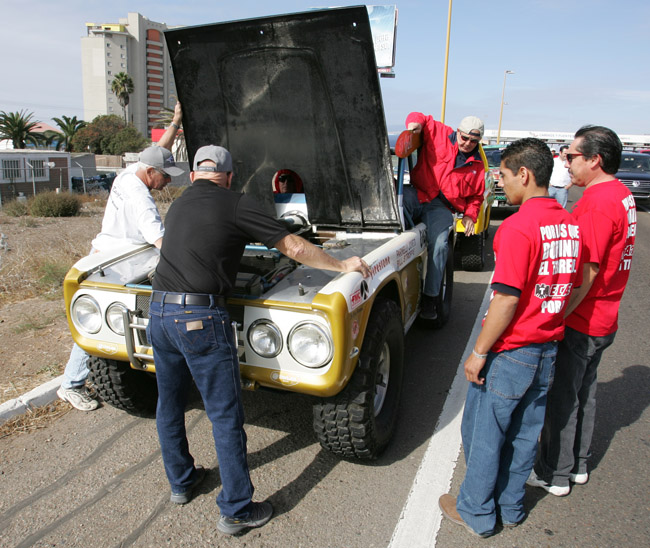As much as Don Garlits’ Swamp Rat 14 was a revolutionary piece in the world of drag racing, Big Oly revolutionized the way guys thought of and built off-road racing trucks in the early ’70s. One can draw a line from the burly Bronco to the insano trophy trucks of today. Bill Stroppe was the unwitting father of this truck. Stroppe had been associated with Parnelli Jones who had been driving his Mercury stock cars in NASCAR competition through the ’60s. Jones was having a lot of success with Stroppe’s innovative and well constructed cars. As legend would have it, Stroppe and Jones got involved in a friendly banter at a Hot Rod magazine Christmas party hosted by Ray Brock in 1967 or 1968. The conversation was capped with Stroppe telling Jones that he didn’t have the stones to race off-road trucks. Jones, known as one of the most guts-out drivers of the era, didn’t take kindly to the remarks and vowed the answer Stroppe’s challenge at the first opportunity.
Jones was tough on equipment, plain and simple. Everything he drove, no matter the genre of car, was normally left a smoking, steaming, leaning, collection of worn parts at the end of a race. He was known for driving cars to, and well past, their breaking points. His first experiences with off-road racing were more like component durability tests, and the trucks failed. He broke hubs, axles, wheels, and so on.
In 1970, Stroppe and Jones rode together to win the Baja 1000 in a very unique Bronco that was slated to be part of a factory two-wheel-drive kit that was to be sold through dealers. When the program died, the remains were sent to Stroppe who built a race truck out of it. He and Jones cruised to an overall victory; the lighter two-wheel-drive truck was far easier on components than the old 4×4 units. The story of Big Oly (the truck was sponsored by Olympia Beer, that’s where the name stems from) starts the moment that Stroppe and Jones began sipping champagne and kissing trophy girls after their win.
Jones was impressed with the performance of the little truck, but it was based on a factory chassis and really didn’t deviate too much from a factory piece. As the story goes, Jones wanted an all conquering truck. Not just one to win class, but one to win the overall race. Big Oly would be that truck, but Bill Stroppe didn’t want to build it. You see, Stroppe was riding the Ford gravy train and he wasn’t going to do anything to upset that deal. In his mind, deviating from the factory chassis would make the truck too far out to be considered a Bronco. He thought that the wigs in Dearborn would not approve. It simply wasn’t a risk he was willing to take. He flatly refused to build the Jones dream truck.
But Jones had other ideas.
He took one of Stroppe’s best fabricators out to lunch, a man named Dick Russell. The basic platform for the truck was sketched on napkins (this sounds like a liquid lunch) and Jones somehow managed to convince Russell to build the truck. The trick was that Stroppe was to know nothing about the project and all the work was to be done at Russell’s home. Their secret plan was destroyed when Stroppe found out. He was not a happy camper, figuring one of his best guys and his best driver were trying to subvert him.
Jones’s power of persuasion came to the forefront again as he convinced Stroppe that the whole pile needed to be moved into Stroppe’s race shop and finished properly there, and it was. As a side note, Stroppe got his revenge: Jones paid for the truck to be finished out of his pocket at the race shop.
The ground breaking thing about Oly was the approach to its construction. Instead of building an anvil that literally couldn’t break, the team took into account many forms of racing and competition to meld those ideas into a package that was suitable for the off-road world.
It’s been said that Big Oly was the first “funny car” of off-road racing. The 4130 chrome moly chassis was designed completely by empirical thinking on behalf of the Stroppe team. They had no design tools or fancy pants computers. They literally made the stuff up as they went along. Mounted on the frame was a narrowed and sectioned Bronco body.
On top was a big adjustable wing to provide some down force and aid traction in the tough desert conditions. The driver could adjust the angle of the wing from his seat using levers in the cab of the truck.
The team used a modified version of Ford’s twin I-beam suspension up front, using the factory concept but completing it with parts suited to the riggors of the desert. Out back the truck used a four-link style suspension with a Detroit locker equipped Ford 9-inch with 4.11 gears. Hurst disc brakes were hung at the corners.
The truck had, for the time, massive wheel travel. The fronts had up to a foot of travel and the rear had up to 10 inches. This was a large part of the truck’s dominating success. That much travel allowed the team to keep the truck on the ground and soak up obstacles that swallowed others whole.
The motor was nothing too exotic, which is good because simplicity is the name of the game if repairs are needed during the Baja race. Packing a 351W that made about 400hp, the motor had an Isky Cam, a 650-cfm Holley double-pumper, a Ford Cobra intake manifold, and custom built headers. The trans started out as a C4, but as time went on the team switched to a C6 unit.
The truck could carry over 40 gallons of fuel in two tanks. It was also equipped with a revolutionary idea: driver refreshment. Two Coleman coolers were mounted behind the seat and the driver and co-pilot had straws that they could use to draw from the cooler.
With all of the innovation present the truck was an unstoppable force for several years in the off-road realm. It won the Baja 1000, not class mind you, but the whole enchilada, in 1970 and 1973, with Jones behind the wheel and Stroppe, screaming at him not the tear the truck up from the passenger seat. Also in 1973, the duo won the Baja 500 and the Mint 400. The truck was a steamroller.
The trophy trucks of today with their wild suspensions and ability to traverse the desert floor complete with ditches, washouts, and even booby traps all descended from Big Oly. While Oly is crude by today’s standards the truck was NASA stuff back in the early 1970’s.
In 1974, Jones suffered a massive wreck during the Baja 500, ending his off-road driving career. He would go on to become a successful team owner in the off-road ranks, continuing a career of success that spanned decades from dirt midgets to Indy cars and everything else in between. Also in 1974, the truck played itself in the classic Gone in 60 Seconds.
The truck was present for the 40th running of Baja back in 2007. The last photo seen here is Freiburger’s shot of Parnelli climbingout while Walker Evans investigates a carb problem at the side of the road in Mexico.
















2 thoughts on “A Pocket Bio Of Big Oly, One Of The Most Famous Off-Road Racing Trucks Of All Time”